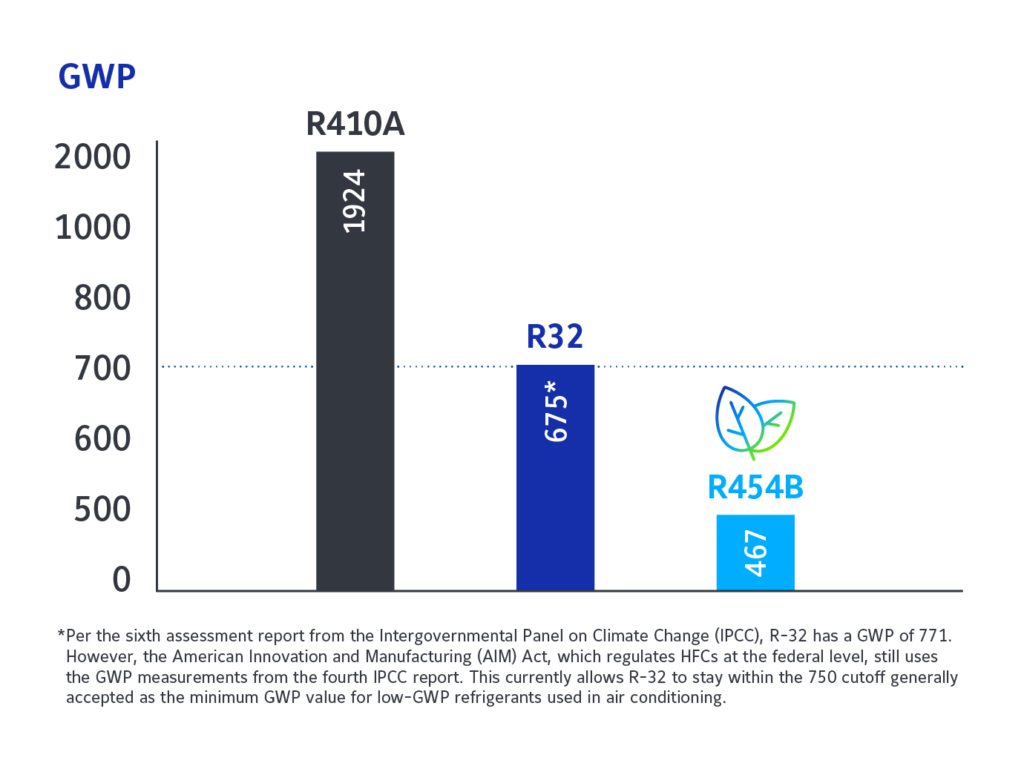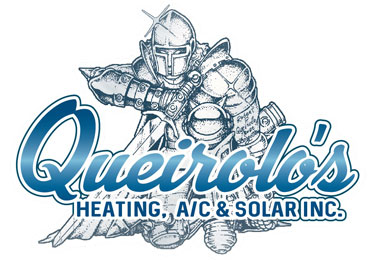Refrigerant Transition
Behind the Low-GWP Refrigerant Transition: R-454B and A2Ls
Making impact-aware decisions in residential and commercial ducted HVAC systems
The New Era of Low-GWP Refrigerants
On December 27, 2020, the American Innovation and Manufacturing (AIM) Act authorized the Environmental Protection Agency (EPA) to phase down the production and use of hydrofluorocarbons (HFCs). This will require HVAC manufacturers to transition to the next level of low-GWP (global warming potential) refrigerants for all new residential and commercial ducted HVAC systems manufactured as of Jan 1, 2025, and installed as of Jan 1, 2026. What does this mean to you as a contractor or building owner? We’re here to answer your questions and help you make the right choices.
Moving From HFCs to Low-GWPs: What Are A2L Refrigerants?
In 2010, the HVAC industry transitioned from ozone-depleting hydrochlorofluorocarbon (HCFC) refrigerants like R-22 to hydrofluorocarbon (HFC) refrigerants such as R-410A. Now, it will make a similar transition to a new generation of low-GWP (global warming potential) refrigerants. The available low-GWP refrigerants fall into a category called “A2L,” which refers to a class of refrigerants with low toxicity and low flammability. The fact that A2L indicates low flammability has some people concerned, and we want to help dispel any misconceptions.
The Realities of Low-Flammability Refrigerants
The first thing to understand during this transition is that not all flammable refrigerants are the same. This makes it an opportune time to solidify our understanding of A2L refrigerants such as R-454B, and how they differ from other flammable refrigerants.
- A2L refrigerants are nothing new. In fact, they are currently used today in systems you may already be familiar with, like room and window air conditioning units. They are just now being allowed in larger-size units, which is an industry first.
- Flammability classes are not created equal. However, the differences in flammability properties of various refrigerants are significant. For example, R-454B is considered an A2L category lower flammability refrigerant and its flammability properties are significantly different than refrigerants in higher A2 or A3 flammability classes, which include propane blends. Check out the video to see how the flammability properties of different refrigerants compare.
- Safety protocols are largely the same. With this lower-flammability A2L classification, many of the best practices commonly used with R-410A refrigerants are still applicable with R-454B. We have developed service and installation training to help our partners in the field during this transition. Talk with your technical services rep for more information.
Our Choice for the Future
Opteon™ XL41 (generically known as R-454B) has been selected as the refrigerant replacement for R-410A in all Johnson Controls residential, light commercial and commercial ducted HVAC applications. Why?- R-454B has the lowest GWP with the best outlook for long-term viability. This reduces the likelihood that another refrigerant transition will be necessary with a future regulatory change.
- R-454B temperatures and pressures are much like R-410A, resulting in similar system designs and a reduced learning curve for equipment service technicians.
- R-454B provides up to a 78% reduction in global warming potential (GWP) while still enabling the opportunity for optimized unit efficiency and decreased energy use.

Frequently Asked Questions
Can I sell and/or install air conditioner units using R-410A after January 1, 2025?
Full split system replacements using R-410A equipment will be prohibited to manufacture as of January 1, 2025, and must be installed by January 1, 2026. There is no current restriction on the sale of parts to service legacy split systems, including components such as condensing units, indoor coils and indoor air handling units. Packaged systems and other self-contained equipment where the refrigerant system is completed at the factory, such as residential packaged equipment and rooftops, are allowed a 3-year “installation sell-through” window for systems manufactured prior to January 1, 20251.
Will R-454B work in existing R-410A systems?
No. R-454B is NOT a drop-in replacement for R-410A. Although many of the characteristics of R-454B are similar to R-410A, the use of R-454B is restricted by code and regulation to systems for which it was specifically designed.
Is there any known drop-in replacement for R-410A?
No. There are not any known, low-GWP (<700 GWP), ASHRAE A1 drop-ins for R-410A in high-probability (unitary) direct systems.
Will R-454B systems require refrigerant detection systems (RDSs)?
RDSs will be required under certain conditions based on things like space dimensions and amount of refrigerant being used. RDS will be factory-installed on some equipment based on need, but not on all sizes & tonnages since it won’t be required for all applications. RDS sensors can be ordered and field-installed where it is deemed necessary. All installers should refer to their local governing bodies for details and requirements regarding the installation and use of RDS for specific applications. Johnson Controls selection tools will provide guidance and assistance with these decisions.
More Frequent Questions can be found on the EPA site linked HERE: https://www.epa.gov/climate-hfcs-reduction/frequent-questions-phasedown-hydrofluorocarbons#OEM-products
1 For more information, contact your local regulatory body.
Glossary of Terms
A2L: A = non-toxic, 2 = flammable, L = low burning velocity
ACCA: Air Conditioning Contractors of America
AIM: the American Innovation and Manufacturing Act gave the EPA authority to phase down HFC use over the next 15 years
ANSI: American National Standards Institute
ASHRAE: American Society of Heating, Refrigerating and Air-Conditioning Engineers
EPA: Environmental Protection Agency
ESCO: standards, validation tools and training resources for the HVACR and building science fields
GWP: global warming potential
HCFC: hydrochlorofluorocarbon refrigerants
HFC: hydrofluorocarbon refrigerants
SNAP: the Significant New Alternatives Policy Rule 23 has approved six new refrigerants for residential and light commercial air conditioning and heat pump applications – all six of these new refrigerants fall into the A2L category
Discover R-32: The Ultimate Refrigerant for Your Air Conditioning Needs
Looking for a refrigerant that offers the perfect balance of environmental friendliness, energy efficiency, safety, and cost-effectiveness? Look no further than R-32. As a crucial component in air conditioning systems, R-32 excels in transferring heat efficiently, helping you save up to 10% on electricity compared to older refrigerants like R-22.
What sets R-32 apart is its lower global warming potential (GWP) and reduced environmental impact. With R-32, you can enjoy a cooler environment while knowing you’re using a more sustainable option.
Concerned about the environment? So are we. That’s why many manufacturers are switching to R-32, phasing out older, less eco-friendly refrigerants, such as Samsung HVAC.
While R-32 is highly efficient, it’s important to handle it with care due to its flammability (A2 under ISO 817:2014). However, its performance and operating conditions are comparable to those of R-410A, making it a reliable and safe choice for your air conditioning needs.
Join the movement toward a more sustainable future with R-32. Upgrade your air conditioning system today and experience the difference!

